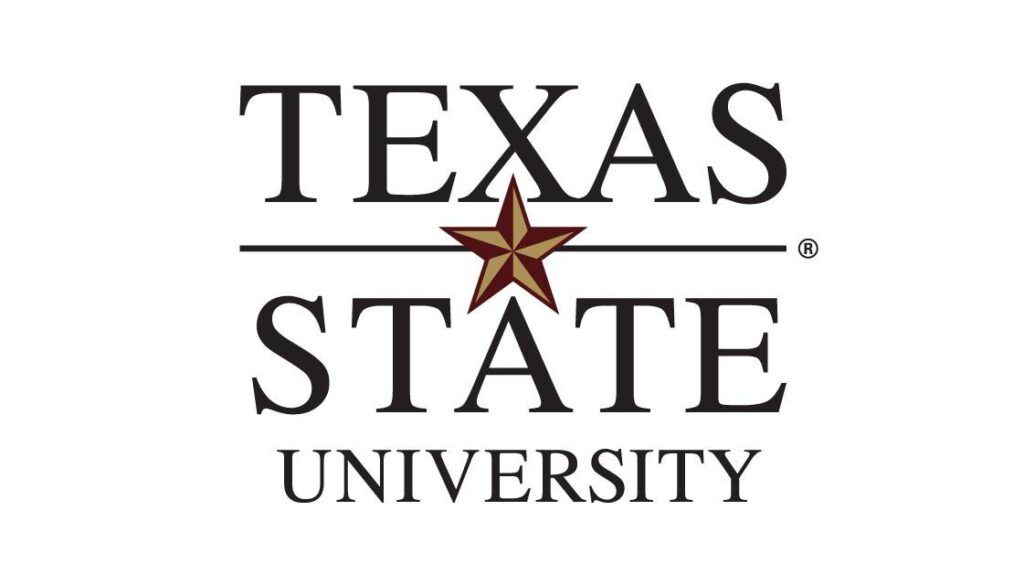musical theatre guidelines
⚠ SUBMISSIONS CLOSED! ⚠
⚠ IMPORTANT! ⚠
If you already saved or submitted an application, please LOGIN to continue.
Prescreen Application Deadline: November 24, 2024, at 11:59 PM CST. [EXTENDED]
Additional audition information can be found here.
Texas State University is a participant in the 2024-2025 Musical Theatre Common Prescreen.
For the 2024-2025 Audition Cycle, MTCP has included a list of helpful hints. We strongly encourage that you take advantage of these resources which have been thoughtfully and intentionally crafted by the expertise of multiple programs nationwide to support the excellence of the audition and for your benefit.
Please visit the Resources and FAQ section of the GetAcceptd MTCP website!
General Information and Tips
- Each piece should be filmed/uploaded as a separate piece of media. No continuous videos.
- Students are encouraged to use standard technology/recording devices available to them (i.e. smartphones, tablets, etc.)
- Solid-colored walls are ideal, but any background that does not steal the focus from your performance is desired.
- Take care that your space allows for adequate lighting. Having a lamp or window directly behind you will cast a shadow over your face. Keep the lighting source behind your recording device or to the side of you so that your face is lit.
- When using pre-recorded music, place the music source (the speaker) closer to you than it is to the device on which you are recording. By having the accompaniment near you, your voice and music will reach the microphone on your device in a more balanced manner.
- Before filming, do a trial run to test both your audio & visual presentation. Watch your video back to ensure everything looks AND sounds okay.
- Ensure the camera portion of your device is at eye level (see example). You can use a tripod built for a smartphone or tablet. If you do not have a tripod, consider using a stack of books on a desk or box. Filming in “landscape” (horizontally) is recommended.
Time Guidelines for All Performance Videos
- All song, monologue, dance, ballet, and wild card videos are recommended to be between 60-90 seconds each.
Prescreen Application
- Introduction/Slate (Required)
-
-
- Record one introduction “slate” video stating your name. if you would like to include your pronouns, state them as well. please speak loudly (project your voice) and clearly (articulate) directly at the camera.
- This is an opportunity for the auditors to get a sense of your personality and to learn the pronunciation of your name.
- There is no need to slate your individual performance videos & pieces. Instead, clearly label each video with your name and the title of the piece you are performing (see more details below).
- Label each video file with the piece you are performing, the show or playwright, and your first & last name.
- Title of Song – Musical/Show – Your First & Last Name
- Title of Play – Playwright – Your First & Last Name
- Examples:
- Slate – James Smith
- Your Daddy’s Son – Ragtime – Minnie Mouse
- Much Ado About Nothing – William Shakespeare – Luke Skywalker
- Examples:
- Framing For Slates, Songs, And Monologues
- Camera framing is simply the placement and position of the actor in the shot. We recommend a waist up frame so we can see your face and hear you clearly.
- Record one introduction “slate” video stating your name. if you would like to include your pronouns, state them as well. please speak loudly (project your voice) and clearly (articulate) directly at the camera.
-
- Songs (Required)
-
-
- Option B
- One musical theater song from any time period.
- One song of your choice from any time period and in any style that best suits you (musical theater, pop, hip-hop, folk, rock, rap, soul, country, punk, etc.). This song should contrast the style of the first selection.
- Tips
- Some examples of contrasting songs are fast tempo vs slow tempo, sustained melodic singing vs speech-like singing, dramatic vs comedic, belt vs head/falsetto mix.
- Many accompaniment tracks are available on YouTube and other websites. If you do not have a way to work with a live accompanist or don’t have access to a recorded track of your music, consider using an app that will play the piano part for you. Harmony Helper is one such app that allows you to take photos of your sheet music, upload them to the app and then generate a piano track that you can use.
- Option B
-
- Monologue (Required)
-
-
- Option A
- One monologue from a published (or written by a professional writer) play. A professional writer is someone whose plays have been produced, but may not have been professionally published.
- Tips
- It is recommended to choose monologues that are age-appropriate (generally within 5-10 years of your actual age) and that feel authentic to your culture, background, and lived experience.
- Active monologues are often better for auditions; an active monologue takes place in real time and focuses on what you want and puts you in direct communication with an imaginary scene partner. This is often more successful in an audition situation than pieces that are a story or remembrance. Additionally, it can be helpful to avoid monologues that rely on extreme emotions as it can be hard to believably justify those responses in a short piece.
- Option A
-
- Dance
-
-
- Option B (Required)
- Show us your best version of dancing or moving.
- Tips
- Make sure you can execute all the choreography well. It is to your advantage to choose steps and movement that highlight your strengths instead of your weaknesses.
- You may use recent videos of you from a show or concert, but it must just be you in the frame.
- Dance sample should be in whatever dance discipline you feel most confident. This may include, but is not limited to jazz, ballet, tap, modern, hip hop, lyrical, contemporary, or dance styles beyond American and Euro-western styles.
- Dance media can be “self-choreographed”, but it must be a solo video of you. This can include a show, competition, or other performance so long as you are clearly featured on your own.
- Please use steps, movement, and physical vocabulary that you are familiar with and can execute well. Fully move your body to the best of your ability.
- To assist applicants with the dance prescreen, several institutions provided the following resource videos for applicants who do not have access to a choreographed combo for the prescreen process. You may submit this choreography (or a combination of it) to any of the schools you are applying to that ask for a dance prescreen. This list will be updated as more institutions share resources, so be sure to check back.
- Ballet (Optional)
- Ballet media is optional
- Option B (Required)
-
- Wildcard (Optional)
-
-
- Think about the wild card section as an opportunity to show your personality or share something about you. This media can be ANYTHING you want – a special skill, an interesting story about yourself, a passion speech, an instrument you play, etc. “What do you want us to know about you?” Below is a list of ideas that have been successful in the past:
- Singing a pop song
- Singing or playing an original composition/song/poem or choreographed dance.
- Performing your own Saturday Night Live-styled skit where you create a comedic character
- Sharing a hobby or activity that means something to you
- Performing in a language other than English in which you are fluent
- Playing an instrument
- Making a “how-to” video on something you are good at, baking, calligraphy, gymnastics.
- If you are a dancer and want to show us a different style you excel in: Tap, Hip Hop, Lyrical, Ballet, etc.
- Think about the wild card section as an opportunity to show your personality or share something about you. This media can be ANYTHING you want – a special skill, an interesting story about yourself, a passion speech, an instrument you play, etc. “What do you want us to know about you?” Below is a list of ideas that have been successful in the past:
-
- Personal Introduction (Required)
-
-
- Our written introduction gives us the opportunity to get to know you, but it also is an opportunity to see if you take direction and actually answer the questions asked (you’d be surprised how many people don’t.) So much of what we do as artists is in the details, and the care with which you approach the requirements of this essay is essential to your success. We put a great deal of weight on the written introduction. In fact, it is the first thing we look at in an applicant’s profile. Please adhere to the requirements for the essay and answer all the questions listed below:
- Requirements for Essay
- Your name must appear in the upper right corner of every page
- Line spacing must be double-spaced
- Margins need to be the “normal” setting of one inch (1”) at the top, bottom, left, and right
- Indent the first line of each paragraph
- All pages must be numbered
- Essay length is 1,000 words or less
- Font: Times New Roman, size 14
- File submitted must be a PDF
- Questions to Answer
- What do you feel is special and unique about you?
- What do you feel your strengths and weaknesses are as a person and as an artist?
- What are your other interests and hobbies not related to theatre?
- What are your artistic interests outside of performing in musicals? (Writing, directing, composing music, plays, film, TV, etc.)
- Helpful Hints:
- Be honest.
- Don’t feel you need to impress us or, conversely, be overly humble.
- Don’t waste time trying to figure out what you think we want to hear.
- We are looking for 12 to 14 unique artists for the Musical Theatre BFA Program who know themselves and will benefit the most from what our program has to offer.
-
- Additional Documentation (Required)
-
- You are required to provide two letters of recommendation. Your recommenders may send this material directly to the Department of Theatre and Dance at the following email address: theatreletters@txstate.edu. Your first and last name must be included in the subject line of the email.
Information about Callbacks
Callback or rejection notifications will be made between November 20 – December 11, 2024.
You are required to apply to the university in addition to the program you are interested in (Musical Theatre or Acting). Both applications should be submitted at the same time. Before you can schedule and attend a callback your university application must be submitted.
When applying to the university please declare your major as Pre-Theatre. This should be your declared major if applying to any of the undergraduate degree programs within the Department of Theatre and Dance. A specific designation of Acting or Musical Theatre is automatically applied after offers are made and accepted.
Callback Dates:
- Virtual: January 18, 2025
- On-Campus: January 25 & February 15, 2025
- Unifieds in Chicago: February 2, 3, 4, & 5, 2025
Additional information about callbacks is available here.
⚠ IMPORTANT! ⚠
If you already saved or submitted an application, please LOGIN to continue.


SUPPORT
If you have any questions about the HeartOut platform and the application process, contact our Tech Support Team at HeartOut.io/support